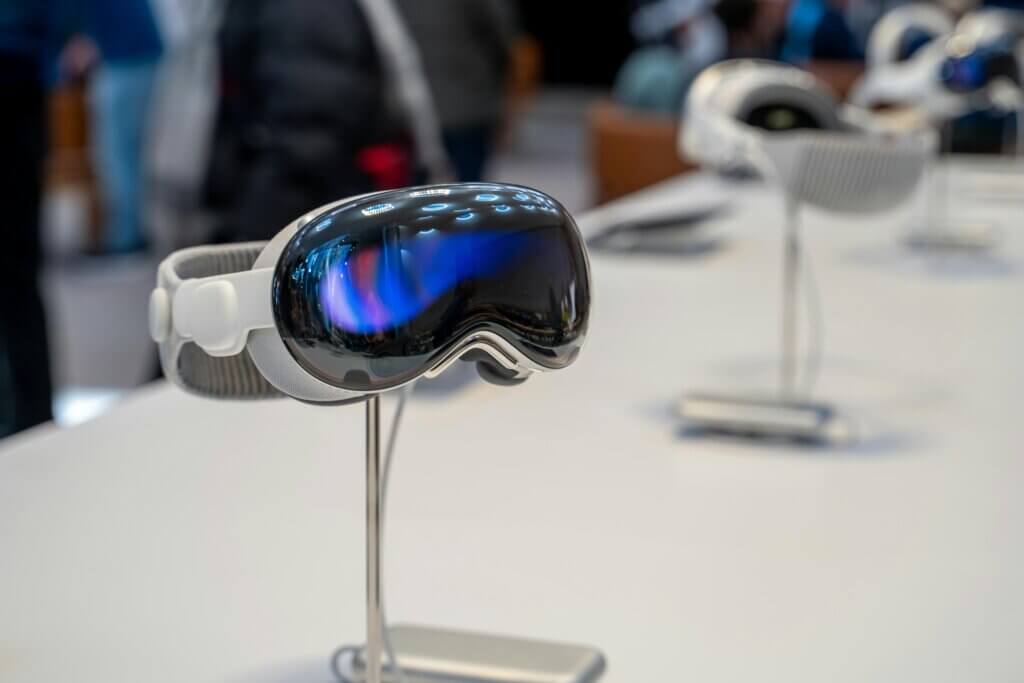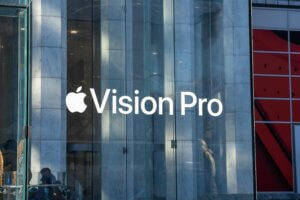After reading this article, you’ll:
- Grasp the transformative potential of Apple’s Vision Pro in healthcare, from revolutionizing medical education with immersive training to enhancing patient care through AR-guided procedures and virtual care spaces.
- Recognize the innovative applications of Vision Pro in telehealth, offering more natural and engaging virtual consultations, and its role in making healthcare more accessible to remote, rural, and mobility-challenged patients.
- Understand the importance of ethical considerations, privacy protection, and the integration of AI and big data to fully leverage Vision Pro’s capabilities in healthcare, ensuring patient well-being remains the paramount concern.

Apple recently unveiled its first foray into spatial computing devices with the Vision Pro headset. Retailing for $3,499, this lightweight headset contains over 12 cameras plus multiple motion sensors to enable advanced augmented reality (AR) and virtual reality (VR) displays. Key features include high resolution screens providing a 120-degree field of view, precise tracking of hand/controller movements, realistic 3D audio, and innovative eye and scene tracking. This allows Vision Pro to seamlessly blend virtual elements with the physical environment. Additionally, Vision Pro leverages powerful on-board computing with Apple’s latest M2 processors.
With these robust capabilities, Vision Pro stands to greatly expand the usefulness and accessibility of immersive XR technologies. The precision of its inputs and visualization unlocks new ways for people to interact with digital content. Its portability enables virtual collaboration from almost anywhere. And its lifelike graphics open doors for more engaging user experiences compared to current smartphone or computer offerings.
The Potential to Revolutionize Healthcare
Apple Vision Pro’s blend of portability, visual fidelity and intuitive controls makes it uniquely suited to innovate healthcare. By leveraging these spatial computing strengths, Vision Pro can transform medical education, enhance diagnosis/treatment, improve patient care, pioneer telehealth options, and make healthcare more accessible.
From VR surgery simulations to AR-guided procedures to immersive virtual care spaces, Vision Pro promises to change how medical students train, how doctors diagnose, how staff deliver care, and how patients receive treatment. This headset could democratize healthcare access in ways previously unimaginable. Essentially, Apple Vision Pro harbors tremendous potential to revolutionize medicine through innovative healthcare applications and new care delivery methods. Let’s dive into the various ways that the Vision Pro may improve healthcare.
Transforming Medical Education and Training
Apple Vision Pro can provide medical students with more engaging, interactive ways to learn anatomy, physiology, and pathology. Its 3D visualizations and AR overlays allow students to manipulate detailed anatomical models, visualize blood flow through organs, see muscular movements, and walk through body systems. Such immersive environments promote deeper learning and information retention compared to static textbooks. Students also gain spatial understanding of anatomy that better prepares them for clinical practice.
New Platforms for Surgical Training Simulations
Simulating surgery is essential for developing surgical skills, but current methods have limitations. Vision Pro’s precise tracking and haptic feedback controllers open the door for highly realistic VR surgical simulations. Students can practice full operations from start to finish, gaining experience in complex procedures before operating on real patients. Repeatable simulations also allow for targeted skill development. Vision Pro provides the visual fidelity and physical interaction to take surgical simulations to the next level.
Continuing Education in VR Environments
 By attending lifelike VR conferences and demonstrations, physicians can more easily fulfill continuing education requirements. Vision Pro allows them to immerse themselves in specialty medical environments to learn new techniques, devices, and best practices. These VR CME courses connect physicians to thought leaders around the world—an eminently scalable educational model as headsets become more widespread. Continual learning is essential for today’s doctors, and Vision Pro can make this learning more convenient and impactful.
By attending lifelike VR conferences and demonstrations, physicians can more easily fulfill continuing education requirements. Vision Pro allows them to immerse themselves in specialty medical environments to learn new techniques, devices, and best practices. These VR CME courses connect physicians to thought leaders around the world—an eminently scalable educational model as headsets become more widespread. Continual learning is essential for today’s doctors, and Vision Pro can make this learning more convenient and impactful.
Enhancing Diagnosis and Treatment
Vision Pro could allow physicians to view a patient’s vital signs, test results, medical history, and other records within their field of vision during exams. This means critical data is always available at a quick glance without looking away from patients. Doctors can also pull up reference materials without disrupting conversations or procedures. This leads to more focused patient interactions, informed diagnoses, and reduced mistakes.
Overlaying Medical Imaging onto Real-World Vews
During surgery or other procedures, Vision Pro can potentially overlay CT scans, X-rays, or ultrasound imaging onto a physician’s view of the patient. This provides vital anatomical context and guidance to locate tumors, navigate delicate structures, or find optimal access points. Layering 2D screen information onto 3D patient space promotes precise intervention with smaller incisions and reduced risk.
Guiding Complex Surgical procedures with AR Visualizations
Vision Pro could allow surgeons to see graphical guides aligned to the patient, including target locations, incision planes, and subsurface structures. This real-time AR assistance improves precision and safety for involved operations like tumor removal or implant placement.
With critical anatomy visible despite obstructed lines of sight, Vision Pro reduces reliance on external displays and makes challenging surgeries more straightforward. Doctors gain superhuman visual perspectives that would otherwise require years more training.
Improving Patient Care and Experiences
Vision Pro can transport hospital patients to comforting VR environments during treatments, procedures, or recovery. Immersive virtual worlds help distract patients from the pain, anxiety, and boredom associated with healthcare visits. Relaxing VR scenes engage multiple senses to promote relaxation as alternatives or supplements to pharmaceuticals. Patients feel more at ease, and healthcare staff can better focus on delivering care.
Allowing Bedridden Patients to Virtually Explore Outside World
For long-term patients unable to leave their hospital beds, Vision Pro offers a temporary escape. With the headset on, patients can simulate adventures like scuba diving, space travel, or exploring new cities from bed. This ability to virtually transport patients expands entertainment options to combat isolation and despair. Vision Pro can greatly improve mental well-being, outlook, and even physical therapy compliance.
Reducing Appointments through At-Home VR Diagnosis and Monitoring
 Telehealth appointments allow patients to communicate symptoms and participate in exams from home. However, restrictions around diagnostic peripherals limit assessable conditions. With its array of onboard sensors, Vision Pro enables more thorough remote diagnoses–checking vital signs, assessing balance/coordination, evaluating sight, etc.
Telehealth appointments allow patients to communicate symptoms and participate in exams from home. However, restrictions around diagnostic peripherals limit assessable conditions. With its array of onboard sensors, Vision Pro enables more thorough remote diagnoses–checking vital signs, assessing balance/coordination, evaluating sight, etc.
Patients skip commutes for minor concerns, while doctors make better use of in-person time. At-home self-monitoring via Vision Pro also helps patients manage chronic illnesses between appointments. Convenience and continuity of care both stand to improve.
Innovating Telehealth and Accessibility
Vision Pro empowers more immersive telehealth consultations between doctors and patients. Lifelike AR avatars projected in place of 2D video create a stronger sense of presence during virtual visits. More natural eye contact and body language foster better conversations and observational assessments. Doctors can also overlay patients with anatomy diagrams, reference models, or other visual aids that are not possible on screens. Overall, Vision Pro unlocks the next evolution of telemedicine.
Overcoming Mobility Challenges through VR Healthcare Access
For homebound patients, traveling to appointments can be enormously difficult. Vision Pro allows them to virtually attend consults, group therapy sessions, and other care visits from their homes. Patients also explore assistive/adaptive technology and accessibility options through VR. By dissolving transportation barriers, more patients get care tailored to their lifestyles and abilities. Virtual accessibility amplifies inclusion for those with limited mobility.
Monitoring Rural/Remote Patients in Real-Time through AR
Vision Pro lets physicians monitor rural and remote patients through two-way AR video feeds. Doctors view patients in context, performing tasks or showing environments factoring into health conditions. This visual perspective and real-time communication support better-informed treatment plans catered to patients’ home settings. Patients also avoid lengthy travel to big hospitals/clinics. Vision Pro thus expands critical healthcare access for traditionally underserved communities.
Future Outlook
While the potential of Vision Pro for healthcare is clear, certain hardware constraints must still be addressed. Continued ergonomic improvements to weight, fit, battery life, and heat dissipation will maximize comfort and usability for long procedures. Maintaining hygienic conditions is also critical, including interchangeable facial interfaces and antimicrobial coatings. Lastly, while Vision Pro is the most affordable high-end AR/VR solution, lowering costs will help scale adoption across varied healthcare settings.
Role of AI and Big Data Integration
As immersive technologies advance, integrating them with artificial intelligence (AI) and big datasets will further enhance capabilities. AI can help automatically surface relevant patient data, predict postoperative risks, recognize anatomical patterns, and generate real-time guidance overlays. Processing population health records promises to uncover diagnostic insights and personalized treatment options. Combining Vision Pro’s visualization with data-driven intelligence promises to push medicine to new frontiers.
Potential Ethical Concerns around Privacy and Behavior Manipulation
While exciting, Vision Pro also raises ethical questions about health data privacy and manipulating behavior/perceptions. As sensitive patient information flows between headsets, stringent cybersecurity and access controls grow in importance. Transparency around if/how Vision Pro environments subtly direct users is critical. Apple’s license agreement bans data collection without consent, but continued oversight is prudent as immersive healthcare evolves. Patient wellbeing must remain the top priority.
Handling inevitable challenges responsibly will help Vision Pro promote health equity and quality of life on an unprecedented scale. This technology’s healthcare impact depends on an ethical, patient-first approach.
Working with an App Developer on a Healthcare App for Apple’s Vision Pro
Developing an innovative healthcare application for Apple’s Vision Pro headset requires finding an app development partner with specialized expertise in spatial computing. Carefully vet potential candidates to ensure competency developing for Vision Pro specifically, including optimizing VR and AR visualizations for the hardware’s capabilities. Look for examples of other physician-grade healthcare apps they have launched showcasing compliance with privacy regulations and 3D visualization proficiency.
Discuss accessibility commitments at length as well, guaranteeing the implementation of alternative voice control options, text alternatives, and other adaptable interface elements that are usable even for those with disabilities. Explore their agile, collaborative process for continually enhancing and supporting apps post-launch. Successful medical software must evolve along with clinical best practices. Overall, the right Vision Pro healthcare developer will fuse technical prowess, design talent, regulatory awareness, and medical user-centricity to transform your ideas into platforms that improve patient lives. With rigorous partner evaluations, you can feel empowered to push spatial computing healthcare innovation to the next level.
Frequently Asked Questions (FAQs) about Apple Vision Pro for Healthcare
FAQ 1: How does Apple’s Vision Pro transform medical education and training?
Answer: Apple’s Vision Pro revolutionizes medical education by providing immersive learning experiences, enabling students to interact with detailed anatomical models in 3D and conduct realistic virtual reality surgical simulations. This approach enhances understanding, retention, and hands-on practice, preparing students more effectively for clinical practice.
FAQ 2: In what ways can Vision Pro enhance the diagnosis and treatment processes?
Answer: Vision Pro enhances diagnosis and treatment by integrating critical patient data into the physician’s field of vision during exams and overlaying medical imaging like CT scans directly onto their view of the patient. This seamless integration of data and real-time AR visualizations aids in precise interventions, informed decision-making, and improved patient outcomes.
FAQ 3: How does Vision Pro improve patient care and experiences?
Answer: Vision Pro offers novel ways to improve patient care by utilizing VR distraction therapy to alleviate pain and anxiety, enabling bedridden patients to virtually explore the outside world, and facilitating more thorough at-home diagnosis and monitoring through its advanced sensors. These applications contribute to better mental well-being and compliance with treatments.
FAQ 4: What role does Vision Pro play in innovating Telehealth and accessibility?
Answer: Vision Pro introduces more immersive and interactive telehealth consultations, using lifelike AR avatars to enhance the sense of presence and facilitate better communication between doctors and patients. It also makes healthcare more accessible by allowing homebound and mobility-challenged patients to attend virtual consultations, thus overcoming traditional barriers to care.
FAQ 5: What are the potential ethical concerns associated with Vision Pro’s application in healthcare?
Answer: The main ethical concerns involve ensuring the privacy and security of sensitive health data transmitted through the device and avoiding any manipulation of patient behavior or perceptions. Apple emphasizes the importance of consent and transparency in data collection, but ongoing oversight is essential to maintain trust and prioritize patient well-being in the expanding use of immersive technologies in healthcare.





